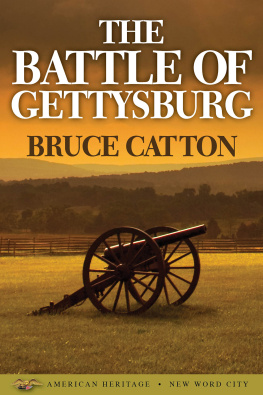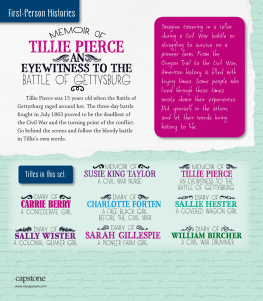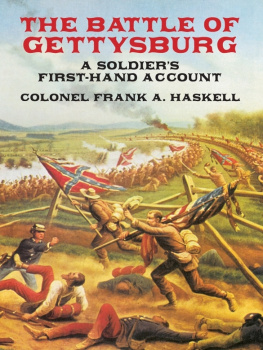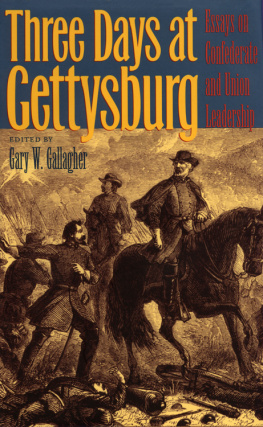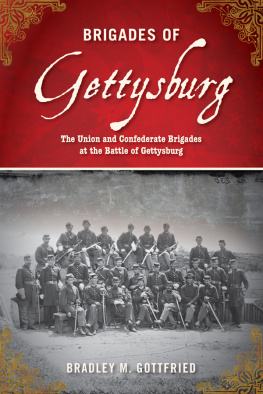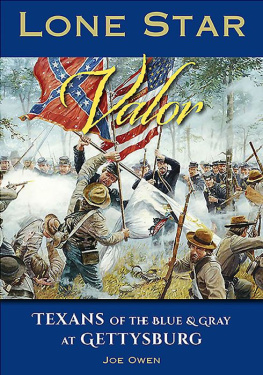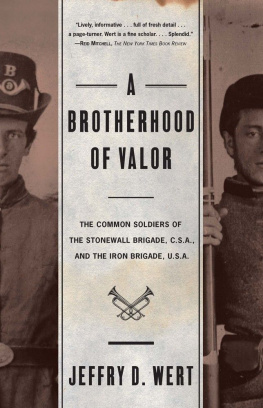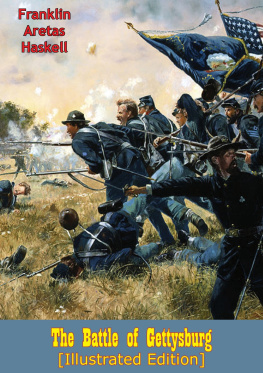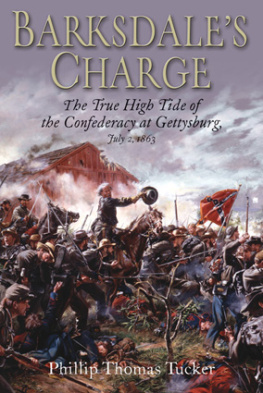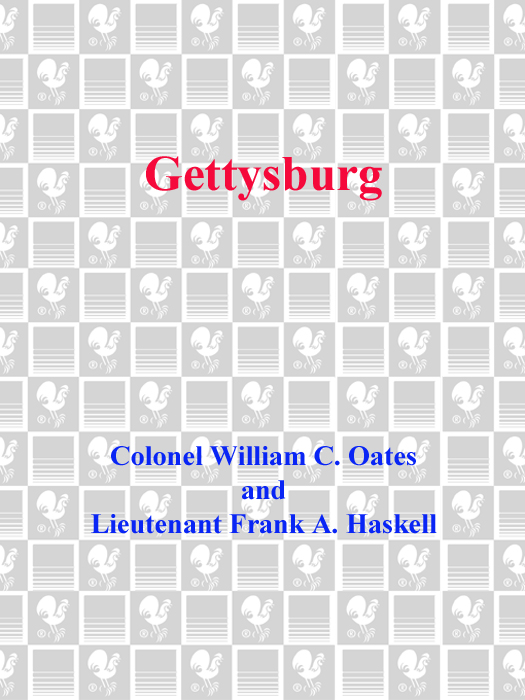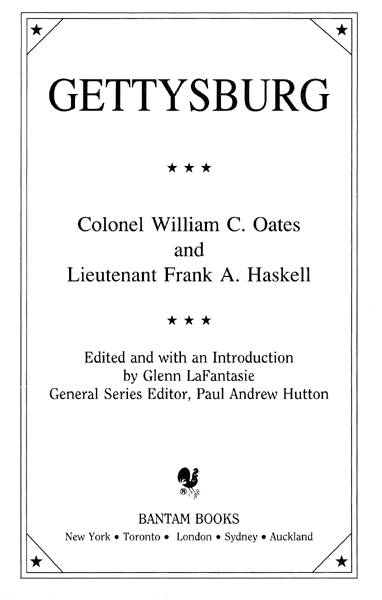A GLIMPSE
INTO THE INFERNO
All senses for the time are dead but the one of sight. The roar of the discharges, over the yells of the enemy, all pass unheeded; but the impassionate soul is all eyes and sees all things that the smoke does not hide. How madly the battery men are driving home the double charges of canister in those broad-mouthed Napoleons! How rapidly these long blue-coated lines of infantry deliver their file fire down the slope.
Men are dropping dead or wounded on all sides by scores and by hundreds; and poor mutilated creaturessome with an arm dangling, some with a leg broke by a bulletare limping and crawling toward the rear. They make no sound of complaint or pain, but are as silent as if dumb and mute. A sublime heroism seems to pervade all and the intuition that to lose that crest and all is lost
Lt. Frank A. Haskell
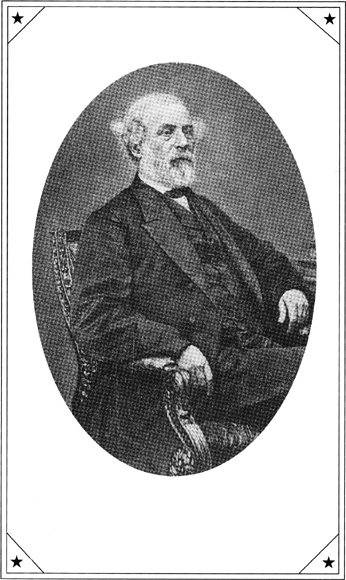
Robert E. Lee (from a photograph taken after the War)
GETTYSBURG
A Bantam Domain Book
Publishing History
William C. Oatess The Battle of Gettysburg was originally published in The War Between the Union and the Confederacy and its Lost Opportunities with a History of the 15th Alabama Regiment and the Forty-Eight Battles in which It was Engaged by The Neale Company, 1905
Frank A. Haskells The Battle of Gettysburg is reprinted with the permission of the Pennsylvania State Archives, Pennsylvania
Historical and Museum Commission,
Harrisburg, Pennsylvania
Bantam edition / September 1992
General Series Editor, Paul Andrew Hutton
All rights reserved.
Introduction copyright 1992 by Glenn LaFantasie.
No part of this book may be reproduced or transmitted in any form or by any means, electronic or mechanical, including photocopying, recording, or by any information storage and retrieval system, without permission in writing from the publisher. For information address: Bantam Books.
eISBN: 978-0-307-76811-7
Bantam Books are published by Bantam Books, a division of Random House, Inc. Its trademark, consisting of the words Bantam Books and the portrayal of a rooster, is Registered in U.S. Patent and Trademark Office and in other countries. Marca Registrada. Bantam Books, 1540 Broadway, New York, New York 10036.
v3.1
EDITORIAL NOTE
The text of William C. Oatess The Battle of Gettysburg has been reprinted from the three chapters dealing with Gettysburg found in his The War Between the Union and the Confederacy and Its Lost Opportunities with a History of the 15th Alabama Regiment and the Forty-Eight Battles in which It was Engaged (New York and Washington, D.C.: The Neale Company, 1905), pp. 189249. Original spelling, punctuation, and paragraphing have been faithfully followed.
The text of Frank A. Haskells The Battle of Gettysburg has been transcribed from the manuscript located in the collections of the Pennsylvania State Archives, Pennsylvania Historical and Museum Commission, Harrisburg, Pennsylvania; the text is reprinted with the permission of the commission. A few rules have been used to prepare the text for modern readers: 1) all spelling, punctuation, and capitalization have been regularized according to modern conventions; 2) paragraphing has been altered to break up Haskells extremely long passages; 3) missing words have been supplied in square brackets, although missing letters from words have been silently restored; 4) a small sketch of the Angle on Cemetery Ridge, which Haskell incorporated into the text of his manuscript, has not been reproduced in this text, although its location and omission are noted in square brackets; 5) all interlineations and other changes presumably made by Harvey Haskell or other editorial hands have been ignored. To avoid a profusion of editorial apparatus, first names of individuals have not been supplied in square brackets in the text. For the full names of most officers mentioned by Oates and Haskell, see the Order of Battle for the Army of the Potomac and the Army of Northern Virginia, which follows the two accounts.
CONTENTS

INTRODUCTION
by Glenn LaFantasie
N o ONE will ever write a complete history of the battle of Gettysburg. So predicted Frank A. Haskell, a resourceful and stouthearted Wisconsin lieutenant who participated in the battle as an aide to Union General John Gibbon and who wrote his own account of what he had seen. According to Haskell, the story of Gettysburg could not be adequately captured in words. Who could sketch the changes, the constant shifting, of the bloody panorama? he asked. Even those who had experienced the battle firsthand could not do it justice. Soldiers in the combat, Haskell said, would be limited by their own literary infirmity and by their not seeing themselves as others would have seen them.
Haskells opinion was echoed by another veteran of the battle, Colonel William C. Oates, the tough and dauntless commander of the 15th Alabama Infantry at Gettysburg. No two men, Oates wrote in the preface to his memoirs, which he composed late in life as a history of the War Between the States, can participate in a great battle and see it just alike. Anticipating that critics of his narrative would be severe in their attacks, Oates pleaded for fair treatment but stated his own defense before the fact: I have ideas of my own and can recognize the truth when I see it, and usually have the courage to express it in a respectful manner whenever it is pertinent to the question in hand. But he emphasized that it is human to err. In a letter written long after the battle to Joshua Chamberlain, the man who had led the Union regiment that repulsed the 15th Alabama at Gettysburg, Oates reiterated that No one man can see all that occurs in a fight, even between regiments.
Like so many other Americans of the Civil War generation, these two seasoned officers believed that no one could ever accurately describe the war or its battles in words. Walt Whitman, who saw the gruesome effects of the Civil War while working as a hospital attendant in Washington, agreed: Future years will never know the seething hell and the black infernal background of countless minor scenes and interiors (not the official surface courteousness of the generals, not the few great battles) of the Secession War; and it is best they should not. The real war will never get in the books. Later generations, who were fairly inundated by the ocean of Civil War writingsmemoirs, reminiscences, letters, histories, and novelsthat continued to be published after most of the veterans had passed quietly away, reached the same gloomy conclusion. Trying to grasp the significance of the war and the experiences of the soldiers who fought it, Sherwood Anderson, the famous novelist, could not overcome his own frustration with the elusiveness of its reality and substance. No real sense of it, he declared, has yet crept into the pages of a printed book.
If we accept these statements at face value, including the ones made by Oates and Haskell, we must suppose that no account of Gettysburg, even those written by men who stood in the thick of the fighting, can adequately tell us what this battle was like or how the soldiers, Union and Confederate, who clashed in the July heat of 1863 must have felt as they stumbled up the steep and rocky slopes of Little Round Top or ran for cover as shells burst around them during the most furious cannonade ever to take place in North America. We must assume, from what Oates and Haskell assert so forcefully and from what many critics and writers have since pronounced as authoritatively, that the battle of Gettysburg will always remain unknown and unknowable.


